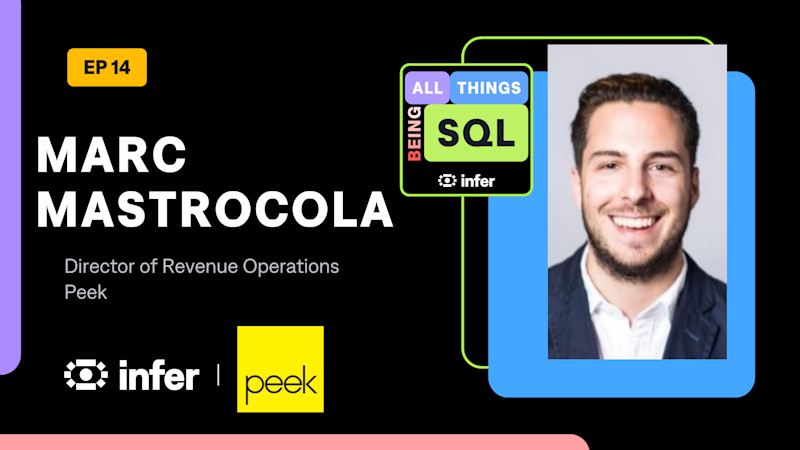Unlocking the Power of Machine Learning in RevOps: A Conversation with Experts
In this Infer <> RevOps Co-op webinar, our very own Ryan Garland, CTO & Co-founder of Infer sat down with Jeff Ignacio, Owner of RevOps Impact, and Freddie Hammond, Senior Director of RevOps at Pinpoint, to explore a key question: When is machine learning the right tool for analyzing data? They broke down everything from testing the strength of a machine learning model to knowing when to pivot to a different approach.
Full recording can be accessed here
When Should You Use Machine Learning for Data Analysis?
There’s no shortage of opinions on what makes a good lead or how to identify a solid expansion opportunity. Machine learning cuts through that noise by eliminating bias and focusing on the signals that *actually* matter. By identifying patterns correlated with success, machine learning can deliver insights that take the guesswork out of the equation.
Many RevOps pros think having a massive amount of data is essential for machine learning. Not quite. It’s all about the quality of your signals. Even with smaller data sets, if the signals strongly correlate with the outcomes you want, machine learning can deliver game-changing results.
Imagine your company sells digital advertising to car dealerships, and you’ve got a special deal with Ford. Because of that deal, Ford dealerships are 80% more likely to buy your product than, say, Toyota dealerships. Plus, dealerships near metro areas are even more likely to close a deal. With this high-quality signal, even if you only have 50 customers out of 21,000 dealerships nationwide, machine learning can help you prioritize leads more effectively.
But let’s flip the script. If you’re selling marketing software to B2B companies with a broad set of use cases and an unclear ideal customer profile (ICP), even 50 customers won’t cut it for lead targeting. Without consistent data—like industry, tech stack, or firmographic details—machine learning won’t deliver reliable insights.
“In practice, I usually say you really need at least a sample size of maybe a hundred if you're going to do lead scoring, but it depends,” Ryan Garland explains.
Want more? Jump to the clip to dive into the conversation on when machine learning shines.
What Makes Data “Good” for Machine Learning?
We all have opinions on what defines an ICP, but do the systems you rely on have the right data to back it up? Often, the data doesn’t line up with what your team *thinks* is a strong ICP signal. Or worse—it contradicts long-held beliefs. This is where pressure-testing assumptions and model outputs comes in.
In machine learning models for lead scoring or forecasting, some fields are more important than others. For instance, if you’re selling to Ford dealerships, it makes sense to buy a list of all U.S. car dealerships and lock down lead-to-account matching. This ensures when a dealership requests a demo, they’re routed to the right rep. Knowing the primary OEM (Original Equipment Manufacturer), proximity to a metro area, and the dealership’s sales volume are all crucial data points for predicting a sale.
Critical data points in this example might include: - Primary OEM - Sales volume - Annual revenue - Zip code - Distance from a metro area
But what if your ICP is murky? Let’s say your company sells to a wide variety of marketers. If you think Marketo users are more likely to convert, grab technographic data from providers like BuiltWith and compare it with your current customer data to test your theory.
“We used machine learning for expansion opportunities and churn analysis. The model revealed some core features and key usage indicators that were highly predictive of renewals—and even identified churn risks, like when a champion user stopped using our product,” shares Jeff Ignacio.
Curious to hear more about ensuring data quality? Check out the webinar clip!
How to Get Your Team On Board with Machine Learning
Machine learning can feel like magic, but humans naturally doubt models when results clash with their instincts. A surefire way to lose trust is to roll out a lead-scoring model without looping in your sales team or explaining how the model works. To avoid this, involve your stakeholders early, explain the findings, and show how the model’s predictions line up (or don’t) with what they know.
Building trust is key. Test your machine learning model against the team’s assumptions. When there are differences, explain why the model diverges and how you’ll incorporate their feedback into future iterations.
“One of the big missions of RevOps is getting everyone bought into being data-led. We use a tool called Runway to share our go-to-market model with the entire team, so they can see what factors are driving the model and the core objectives,” says Freddie Hammond.
---
The Big Takeaways
This panel covered a lot of ground, from the types of machine learning models to the best data points for customer analysis. Machine learning has huge potential for RevOps, but like any tool, its success hinges on how you use it. Curious to dive deeper? Check out the full webinar for all the insights!


